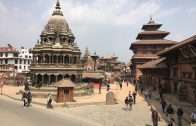Nepal’s ancient city of Patan
Patan is one of the largest cities in Nepal and is located just across the Bagmati river from Kathmandu. Also known as Lalitpur, both names derive from the Sanskrit “Lalitapattan”.
Like its larger neighbour, Patan also boasts a Durbar Square full of temples, statues, and palaces as well as the Patan Museum. Many of the temples were destroyed in the April 2015 earthquake.
Durbar Square is the Palace Square of Patan. The Palace was built on the site of a fort that stood until 1734 and served as the residence of the Malla rulers of the then Patan state. It is divided up into a succession of courtyards (or “chowks”). The first palace building is Sundari Chowk which was constructed in 1647. The three-storey temple on the palace side is the Degutale temple, constructed in 1661 after an earlier one burned down. Mul Chowk was the central part of the old palace and in recent times has suffered much theft of ornamental woodwork.
There is a confusing array of temples and other interesting items on the left-hand side of the square, walking from the south end of the square, you pass:
- Octagonal stone Krishna temple, constructed in 1647.
- A huge bell that dates back to 1737 and is still rung once a year.
- The Shankar Narayan temple, with kneeling stone elephants in front.
- The temple with a statue of Yognarendra on a pillar in front.
- Two smaller temples dedicated to Vishnu, dating back to 1590 and 1652.
- The oldest temple in the complex, dating back to 1566.
- A stone temple to Krishna, considered to be a masterpiece, with some amazing stonework. Note the Garuda on the pillar in front, which has eyes of crystal.
- The Vishwanath temple, with two stone elephants and riders in front.
- The Bhimsen temple, constructed in 1680 but with more recent marble additions.
South of Durbar Square
- Mahaboudha Temple, (5-10 minutes walking distance from Durbar Square). This is a stone temple covered with terracotta tiles, which include 1008 Budha images. It was modelled on a larger temple in Bodhgaya, India and took one family four generations to complete.
- Rudravarna Mahavihar (also known as Uku Bahal). A gem of a temple close to Mahaboudha, but much less visited. One of the oldest temples in the Kathmandu Valley with some strange and interesting statues.
- Machchhendranath temple. This is a good illustration of the problems now faced with theft of artefacts. The temple is now surrounded by a strong fence and each statue has its own individual fence. Statues are missing from two stands, suggesting that the temple has already fallen victim. Machchhendranath also gives his name to an annual festival when a 25-meter tall “chariot” is paraded through Patan. The parade takes place between April and June, with the chariot staying the night at different locations. The end of the parade is supposed to coincide with the onset of the monsoon rains. The wheels of the chariot are over 2m in diameter. For the rest of the year, these can be seen in the building next to the Ashok Stupa.
North of Durbar Square
- Golden Temple (Hiranayavarna Makavikar). An enormous amount of gold- and silver-covered decorations and some excellent bronze statues make this well worth being the only temple in Patan you have to pay to enter. Construction goes back to the early 1400s, although some pieces pre-date construction.
- Kumbheshwar Temple. One of the two five-story pagoda temples of the Valley. The sunken basin is usually empty but around August is filled for the Kumbheshwar Mela full moon day festival. At this time the temple becomes packed. Sheep roaming the temple are those that have been spared sacrifice.






